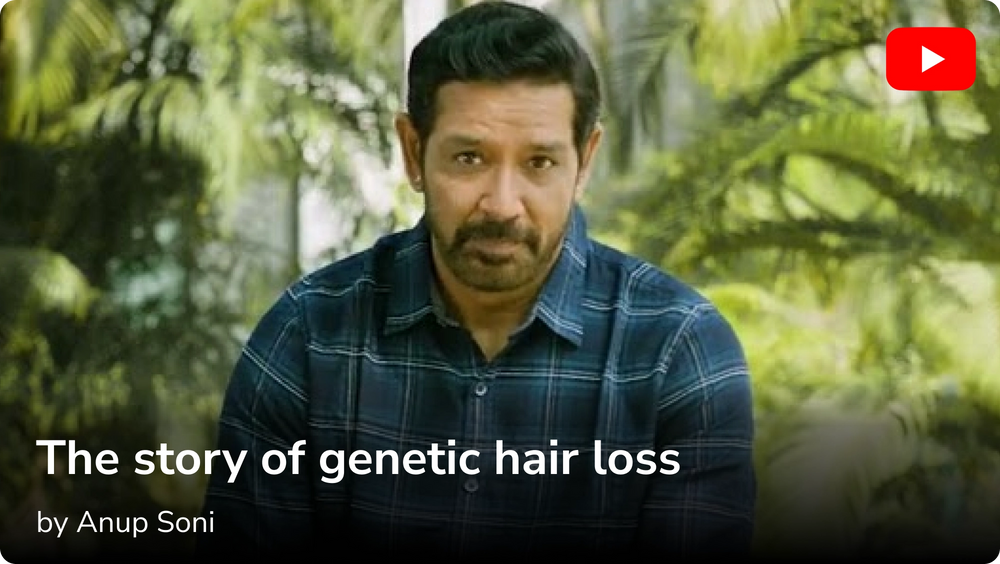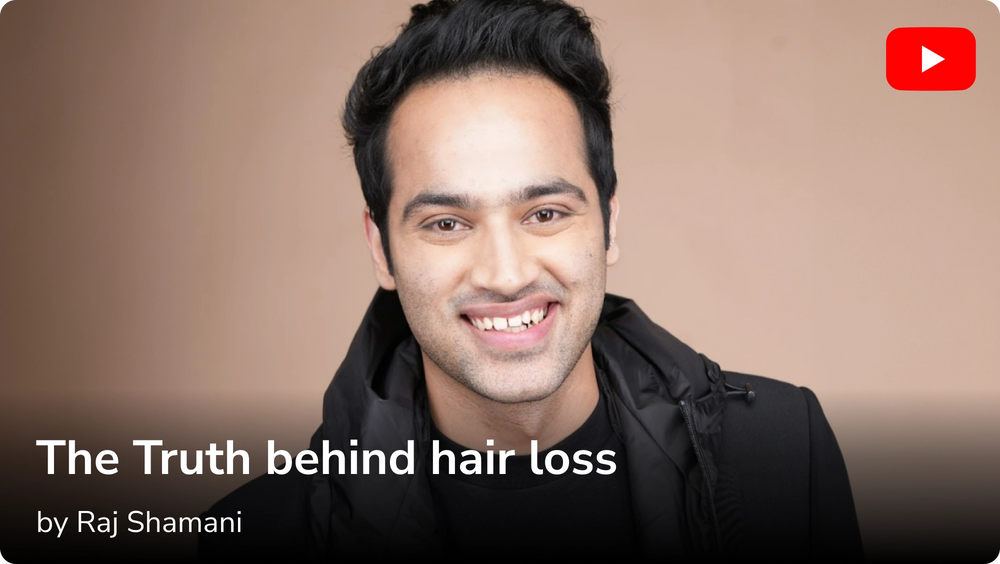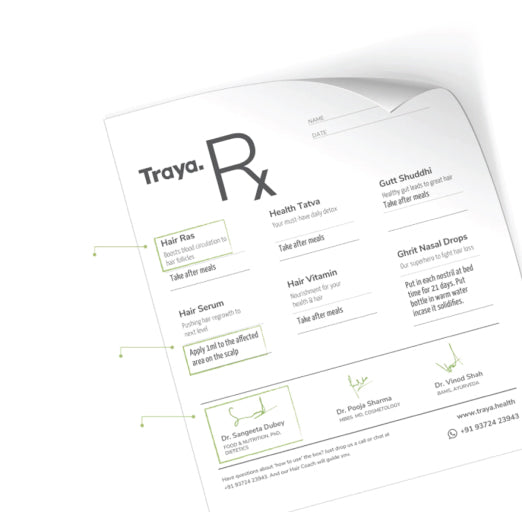Hair Fall: Not Just a Problem, But an Industry
Hair fall is no longer just a cosmetic concern it’s become part of a massive industry. In India alone, the hair care industry is worth thousands of crores. But the real question is are the promises and solutions offered by this industry actually trustworthy?
Why did we create this podcast?
Millions of people spend money daily on products that make grand claims but deliver no results. This video and article aim to cut through the confusion and bring the truth to light. It’s a roundtable discussion where industry experts openly talk about how consumers are misled through advertising, claims, and half-baked scientific facts.
Who participated in this discussion?
The roundtable included Traya’s medical team, Ayurvedic experts, dermatologists, and marketing analysts. With their experience and expertise, this video is not just opinion it’s backed by facts and medical realities.
Purpose of this article
This article aims to help you become an informed consumer. Don’t let flashy product names, packaging, or claims like "99%" mislead you. Let’s uncover how the hair fall industry actually works.
Watch our complete Podcast:
The Marketing Manipulation Playbook
Where does the deception start?
You may have seen claims like “99% hair fall control.” But have you ever wondered what does that 99% refer to? It often represents breakage, not actual hair root shedding.
Transcript: “99% reduction in hair fall is usually breakage-related, not root fall.” (05:30)
These claims are often made when comparing products to non-conditioning shampoos which are known to cause breakage. Brands choose these test conditions intentionally to show better results, even though they don’t reflect real-life usage.
Transcript: “Brands test their products against ‘non-conditioning’ shampoos, which are known to cause breakage. That’s how they get high numbers.” (06:15)
Brands decide the claim first, then find science to support it
It was revealed that many brands first decide what they want to claim like “makes hair thicker” or “boosts hair growth” and then find or conduct a study that barely supports it. This is called reverse engineering.
Transcript: “Most companies decide the claim first, and then they create a formula that barely supports that claim.” (20:15)
A claim worth crores based on a 20-person trial?
Most brands use small sample sizes like trials on 20–30 people and highlight a few positive results to drive mass marketing.
Transcript: “Clinical study of 24 people shows 10% increase in thickness? That becomes the headline for millions of customers.” (21:05)
Buzzwords that win trust
Words like:
-
“Clinically Tested”: Doesn’t guarantee effectiveness or backing by a reputed institution.
-
“Dermatologist Recommended”: Often just one doctor’s personal opinion.
-
“Rx Packaging”: Creates an illusion of medical legitimacy, but it’s still an over-the-counter product.
Transcript: “Rx likhne ka matlab prescription drug nahi hota. It just looks legit.” (07:10)
The Myth of ‘Natural’ Products
Onion, Amla, Aloe Vera just for show
Many so-called natural products list Ayurvedic ingredients like aloe vera, neem, amla, or onion. But in reality, these are present in such minuscule quantities that they have no real effect. They're only added for the “feel-good” factor.
Transcript: “They say 'goodness of onion', but onion extract hota hi nahi formula mein.” (45:00)
Natural ≠ Safe
“Natural” doesn’t always mean safe. Ingredients not scientifically tested can cause irritation, allergies, or inflammation.
Transcript: “Natural doesn’t mean safe. Bina test kiye kuch bhi scalp pe laga dena dangerous ho sakta hai.” (54:30)
Adverse reactions often hidden
Most companies suppress reports of side effects or dismiss them as “rare cases,” though such cases should be disclosed responsibly.
Transcript: “Brands rarely highlight negative effects unless lawsuits happen. Even then, they silently reformulate.” (55:20)
Science vs. Scams
Only Minoxidil and Finasteride are FDA-approved
These are the only two treatments approved by the US FDA for hair loss. However, many market products look like them but are far less effective.
Transcript: “Only Minoxidil and Finasteride have FDA backing. Rest are just cosmetic agents.” (01:04:50)
Misleading comparisons with Redensyl
Redensyl is often compared with 1% Minoxidil even though the effective dose of Minoxidil is 5%, creating a false impression of efficacy.
Transcript: “Redensyl ko Minoxidil 5% se compare karo toh pata chalega ki kitna farq hai.” (57:45)
“No Added Chemicals” = Marketing term, not science
Everything is made of chemicals this phrase is scientifically meaningless.
Transcript: “Sab kuch chemical hai. 'No added chemical' sirf ek marketing line hai.” (01:06:40)
Why Diagnosis Is Crucial Before Treatment
Treatment without diagnosis is ineffective
Hair fall can stem from genetics, hormones, deficiencies, stress, or medical conditions. Without diagnosing the root cause, no topical treatment can be effective.
Transcript: “Diagnosis ke bina koi bhi product kaam nahi karega.” (01:05:10)
Real causes: Thyroid, stress, Vitamin D/B12 deficiencies
Blood tests are essential before starting any treatment.
Transcript: “Hair loss ke peeche multiple reasons hote hain thyroid, stress, deficiency. Test karwana zaroori hai.” (01:05:40)
“One-size-fits-all” doesn’t work
Every individual has unique scalp and body types treatments must be personalized.
Transcript: “Same lotion har kisi ke liye kaam nahi karta. Customize karna padta hai based on condition.” (01:10:00)
Hair Loss Myths and Truths for Women
Women can use Minoxidil but with medical guidance
There’s a common myth that Minoxidil is only for men. The truth is, the FDA has approved it for women too, especially in cases of Female Pattern Hair Loss (FPHL). However, it must be used under a doctor’s supervision because hormonal profiles and scalp types vary among women.
Transcript: “Yes, women can use Minoxidil, but it has to be prescribed based on their pattern of hair loss and hormones.” (01:18:50)
Many women start using it on their own and stop when they experience initial shedding, which is a normal phase in the first 2–4 weeks. Proper guidance and consistency are key.
Don’t trust social media consult a doctor
Hair loss in women can be due to hormonal imbalance, thyroid disorders, postpartum changes, or PCOS. But social media advice often ignores these issues and pushes random shampoos or oils.
Transcript: “Social media ka solution general hota hai, aapka hair loss specific hai. Doctor se samajhna padta hai.” (01:19:30)
The Truth About DIY and Home Remedies
“Onion juice grows hair” Myth or fact?
Onion juice is popular in India as a home remedy. Experts clarified that while sulfur in onion may increase blood flow, it doesn’t regrow hair.
Transcript: “Pyaaz ka ras anti-inflammatory ho sakta hai, lekin usse regrowth nahi hoti.” (44:45)
Prolonged use can cause irritation or allergic reactions, especially on sensitive skin. It’s a cheap and accessible option, but not scientifically proven.
DIY = Psychological comfort, not scientific cure
People turn to home remedies for emotional relief, especially when they lose trust in market products. However, science says DIY may offer scalp cleaning or minor conditioning at best not real treatment for hormonal or nutritional causes.
Transcript: “DIY helps you feel in control, but it’s not addressing the root problem.” (45:50)
Most DIYs fall under the placebo effect you feel better simply because you’re doing something.
How Brands Create an Illusion
Visual and verbal deception
Marketing is now more about visual manipulation. “Before-after” photos often use lighting, angles, styling products not actual hair regrowth.
Transcript: “Before-after images are often just styled differently, not actual regrowth.” (08:15)
Terms like “make your hair thicker” confuse people thicker strands ≠ more hair density.
Transcript: “Thickness aur density mein farq hota hai. Brands isko interchangeably use karte hain.” (08:55)
Fear sells products
Phrases like:
-
“If you don’t act now, it’ll be too late.”
-
“Are your roots falling out?”
-
“Your hair needs nutrition before it’s too late.”
These create panic and push quick purchases.
Transcript: “Fear sells. Brands make you panic, so you buy.” (09:40)
FOMO and herd behavior: Marketing also uses FOMO (Fear of Missing Out):
-
“2 lakh people tried this. Have you?”
-
“#HairGoals is trending on Instagram!”
Transcript: “When you see a trending product with 5M views, you assume it works. That’s not evidence.” (10:20)
Long-Term vs. Short-Term Results
Early improvement = psychological effect
New products may create a feeling of improvement shine, cleaner scalp, slightly less hair fall. But this is often placebo, not real biological change.
Transcript: “First 2–3 weeks improvement is often just psychological. Real regrowth takes months.” (01:12:00)
Real results need patience
Hair growth goes through phases: Anagen (growth), Catagen (transition), Telogen (resting). Any effective treatment takes 4–6 months minimum.
Transcript: “Hair cycle takes months to reset. Real solutions respect biology, not marketing.” (01:12:40)
Short-term hacks can be harmful
Brands use ingredients like silicones, mineral oils, or volumizing agents that make hair look fuller temporarily but harm long-term health. This traps consumers into a cycle of dependency.
Set realistic expectations
If a product promises results in 14 days, it’s a red flag.
Transcript: “If a product says you'll see a difference in 14 days RUN.” (01:13:15)
When the Product Becomes the Problem
Using products without diagnosis is risky
Many people try new products based on social media or friends’ advice without understanding the root cause like deficiencies or hormonal imbalance which makes the problem worse.
Transcript: “Blind product use without diagnosis can worsen underlying issues.” (01:12:50)
Misleading words like “Herbal Blend”
Words like "Herbal Blend" or "Botanical Extracts" sound safe but are not scientifically defined.
Transcript: “Herbal blend is often a marketing labelthere’s no standard or science behind it.” (01:12:25)
Some “natural” ingredients can actually cause dryness, irritation, or worsen scalp conditions.
The trap of constant product switching
Trying different products every few days doesn’t allow the scalp to adjust, often causing more irritation and damage.
Who is responsible?
Everyone plays a role brands, marketers, and consumers. But consumers must educate themselves and read labels before using anything.
Tips:
-
Always consult a doctor
-
Do a patch test for new products
-
Don’t blindly trust terms like “Natural” or “Herbal”
-
Your scalp is sensitive and deserves care not experiments
What Rights Do Users Have?
When brands mislead you what can you do?
In the world of hair care products, consumers are often misled by vague claims, incomplete research, and deceptive ads. But as an informed buyer, you have rights and it’s important to know and exercise them.
Transcript: “Most people don't even know they can file a complaint against misleading hair claims.” (36:45)
If a product causes side effects or fails to deliver promised results, you can raise complaints through official channels.
A. ASCI – Advertising Standards Council of India
ASCI is a voluntary organization that monitors advertising standards in India.
Examples of complaints you can file:
-
“100% Hair Growth Guarantee” without proof
-
“Dermatologist Recommended” without credible verification
How to file a complaint:
-
Visit asci.social
-
Fill out the online form with details and screenshots
-
ASCI will seek a response from the brand and can get the ad removed
Transcript: “ASCI pe complaint karo, wo claim ya ad hata dete hain.” (38:40)
B. CCPA – Central Consumer Protection Authority
If it’s about product quality, health impact, or fraud, you can file a legal complaint through the government’s consumer platform.
Steps:
-
Go to https://edaakhil.nic.in
-
Submit your complaint with supporting evidence (reports, bills, brand communication)
C. Social Media as a Platform
While not legal, social media can be a powerful tool. A genuine and documented complaint can create public pressure and alert others.
Example:
“I used XYZ serum, and my hair fall worsened. The brand didn’t help. Be careful.”
Transcript: “Use social media to share your experience. It creates accountability.” (39:10)
D. The System is Made to Feel Complicated
Often, brands make the complaint process so complex that people give up. That’s a tactic to discourage accountability.
So:
-
Document your experience
-
Keep records of conversations
-
Be persistent
Why is complaining important?
-
It’s your right and your responsibility
-
It holds brands accountable
-
It protects future consumers
Transcript: “Shikayat karna ek zimmedari bhi hai. Nahi karoge toh brands sudhrenge nahi.” (40:45)
What Actually Works?
Not Instagram Reels, but Doctor Reports
There’s no single solution for hair fall it could be due to thyroid issues, nutrient deficiencies, stress, genetics, or hormonal imbalances. No oil, shampoo, or home remedy can treat all of these.
Transcript: “Diagnosis ke bina koi bhi product kaam nahi karega.” (01:05:10)
Start by consulting a specialist (dermatologist or trichologist) who can suggest tests like:
-
Thyroid Panel (TSH)
-
Vitamin D & B12 levels
-
Iron profile
-
Sleep or stress evaluation
Based on the results, a personalized treatment plan is much more effective and safe.
Personalized Treatment Is Real Treatment
Everyone’s scalp is different oily, dry, sensitive, etc. So the same product won’t work for everyone.
Brands like Traya use a multi-science approach combining Ayurveda, dermatology, and nutrition to create tailored treatment plans.
Transcript: “One-size-fits-all approach doesn't work. Get your diagnosis.” (01:10:40)
This personalization leads to long-term solutions, even if it takes time. Instagram ads may show quick fixes, but only medical guidance offers root-level care.
Conclusion
This isn’t just a hair story it’s a trust story
Dealing with hair loss can be deeply emotional. That’s where brands play their biggest game by selling big promises, glossy packaging, and confusing words to exploit your vulnerability.
This entire discussion and article reveal that there’s a lot hidden in the hair care industry. The most important truths are the ones that brands don’t tell you.
-
“Clinically Tested” doesn’t mean it works for you
-
“Natural” or “Herbal” may just be marketing tricks
-
DIYs and home remedies are not scientifically effective
-
No treatment works without a proper diagnosis
As mentioned in the roundtable it’s vital that consumers don’t act based on advertising alone. True hair recovery begins with understanding the root cause and treating it accordingly.
Be Aware. Ask Questions. Demand Evidence.
In today’s world, the most powerful tool you have is awareness. If a product claims “99% results”, you have every right to ask On what basis? Tested on whom? Approved by whom?
Transcript: “If you don’t understand a claim, first try to understand what it actually means.” (01:20:15)
Next time you hear a hair product claim Pause. Ask. Investigate.
This isn’t just information it’s an appeal. Take responsibility for your hair, your body, and your money. The next time you feel tempted to buy something after watching a social media ad ask yourself:
Is this truth or just clever marketing?
Frequently Asked Questions (FAQs)
Can shampoo make hair grow?
No. Shampoos are meant for cleansing the scalp. They don’t stay on long enough to stimulate hair growth.
“Shampoo’s job is cleansing, not promoting growth.” (01:15:20)
Does onion juice help hair growth?
It may reduce inflammation slightly, but it’s not clinically proven to regrow hair.
“Onion juice can be anti-inflammatory, but not proven for regrowth.” (44:50)
What’s the difference between Redensyl and Minoxidil?
Minoxidil is FDA-approved and proven. Redensyl is newer and often falsely compared to 1% Minoxidil instead of 5%.
“Comparing Redensyl with Minoxidil 1% is misleading.” (58:00)
Can women use Minoxidil?
Yes, but only under medical supervision. Dosage and formulation differ for men and women.
“Women can use Minoxidil, but only under medical supervision.” (01:17:10)
Is hair fall just a scalp problem?
No. It can be due to thyroid imbalance, stress, or vitamin deficiencies. Diagnosis is essential.
“Hair fall is linked to nutrition, stress, hormones all of it.” (01:18:10)
What does “Clinically Tested” actually mean?
It just means it was tested maybe on a small group or in a basic lab. It doesn’t mean it’s effective or safe for everyone.
“Clinically tested doesn’t mean clinically proven.” (01:06:35)
Are natural products always safe?
Not always. Many natural ingredients can cause allergies or irritation. "Natural" is often a marketing term.
“Natural doesn’t mean safe or effective.” (54:30)





















